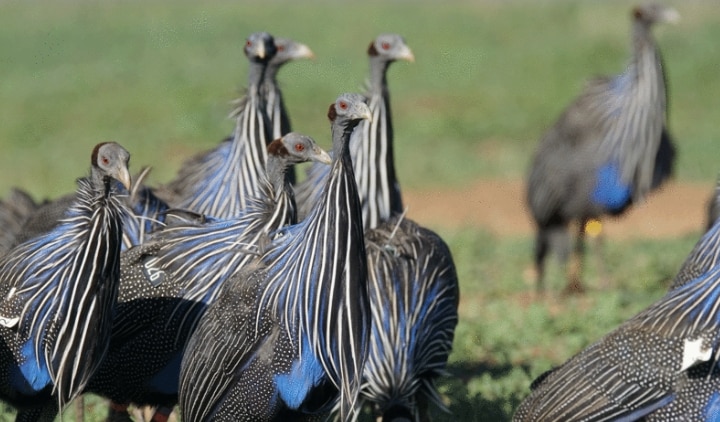
These Beautiful Blue Turkey-Like Birds Have Tiny Brains and Huge Social Networks
by Jason Daley/Smithsonian.com
One hallmark of an intelligent animal is the development of multilevel societies, full of complex relationships. Humans, baboons, giraffes, elephants and even dolphins divide themselves into family units that are part of larger clans that may have ties or relationships to other groups. Keeping tabs on dozens—or even hundreds of social relationships—requires the firepower of big mammalian brains—or so scientists thought.
A new study published this week in the journal Current Biology about an East African bird species with a pretty small brain reveals that animals may not necessarily necessarily need to be smart to be social.
While ornithologist Damien Farine of the Max Planck Institute of Animal Behavior was completing his postdoctoral research, he actually didn’t study birds at all. Initially, he analyzed multilevel relationships among baboons in Kenya. It was then when he first noticed that the vulturine guineafowl wandering around his research site seemed to live in stable groups and exhibited some of the same social behaviors as the primates, reports Elizabeth Preston at the New York Times.

Carol graduated from Riverside White Cross School of Nursing in Columbus, Ohio and received her diploma as a registered nurse. She attended Bowling Green State University where she received a Bachelor of Arts Degree in History and Literature. She attended the University of Toledo, College of Nursing, and received a Master’s of Nursing Science Degree as an Educator.
She has traveled extensively, is a photographer, and writes on medical issues. Carol has three children RJ, Katherine, and Stephen – one daughter-in-law; Katie – two granddaughters; Isabella Marianna and Zoe Olivia – and one grandson, Alexander Paul. She also shares her life with her husband Gordon Duff, many cats, and two rescues.
ATTENTION READERS
We See The World From All Sides and Want YOU To Be Fully InformedIn fact, intentional disinformation is a disgraceful scourge in media today. So to assuage any possible errant incorrect information posted herein, we strongly encourage you to seek corroboration from other non-VT sources before forming an educated opinion.
About VT - Policies & Disclosures - Comment Policy




Am I being censored by my most-favorite site? Please to let me know. Thot you were sq & level
Mr.Ed,
Not really sure what you mean by censored. I do know that you can only use X (?) amount of characters in a comment before it will take no more and when you go to post it your comment is gone. I have no idea why there is a limit. We would have to ask Word Press I guess. Just add more comments with fewer words until you have you comment ideas completed and people will be able to follow.
I tried
Nothing beyond 1500-words? Not from a highly-respectable creature such as I am?
My concluding comments would’ve concerned themselves with truthful issues. If you invite me to continue this avian-based discussion (including swarm-mentality) I am right here. Other-ways, I am marooned WHAT?? From your biggest fan: I am non-plussed as to why your server has a 1500 limit. ALL of my comments are intended to be wholesome truth. Kind regards.
Nice article from Smithsonian. I wonder: advert-laden that it is, do they offer an ad-free subscription? I searched but no results were obtained (possibly because of my IT illiteracy). But birds do fascinate ‘ground-bound’ creatures and for millennia, at that: whether Icarus, Prometheus, The Augury Priests of Rome or, more recently by Konrad Lorenz (Sp?) in his opus entitled: “Solomon’s Ring.” Lorenz describes a “Caucus of Crows” during which one questionable crow has been isolated and forced to roost alone while the “Murder of Crows” (cf. “An Exaltation of Larks”) roost nearby and decide whether to rehabilitate the reprobate offender or to peck-out its eyes (both judgment & execution). Allow me to mention that Lorenz once fashioned a prosthetic to replace the ‘tail’ of an injured dragonfly. Back to crows, I personally worked with a knowledgeable man who kept a pet crow with a split-tongue (enabling ‘speech-capabilities’). My friend was allowed to walk into his favorite local bar with that bird on his shoulder. After two-years of ‘companionship’, the crow took-flight, likely back to face the aforementioned caucus. My friend’s nickname was “Mountain Man” (PA) who plucked two-foot snapping turtles he once found a mythical “Witches Broom,” a conifer tree’s branch (oddly horizontal with a bushy extremity) which supposedly proffers ‘good-luck’ upon the viewer. WOW! Apologies for being long-winded!
Comments are closed.